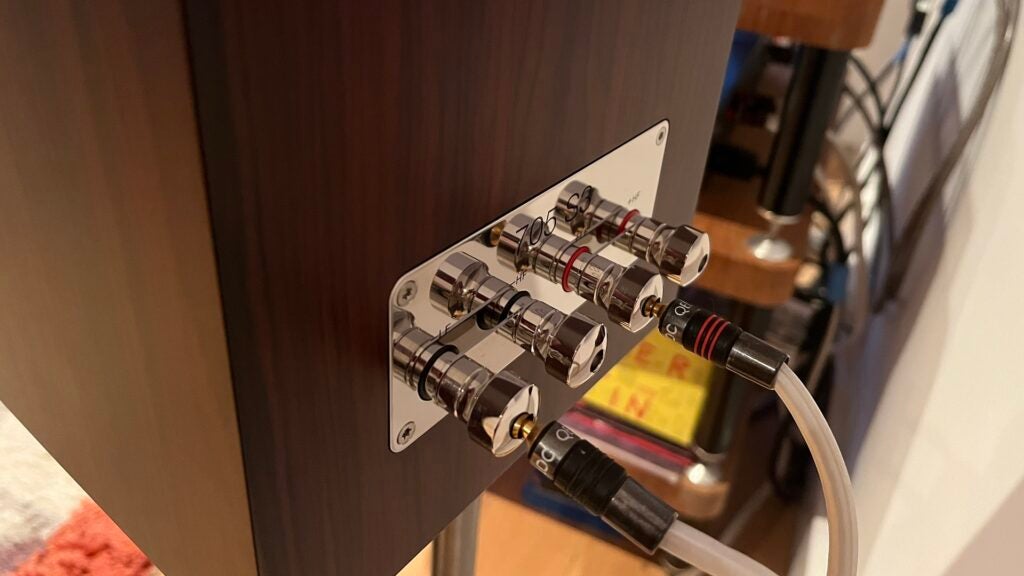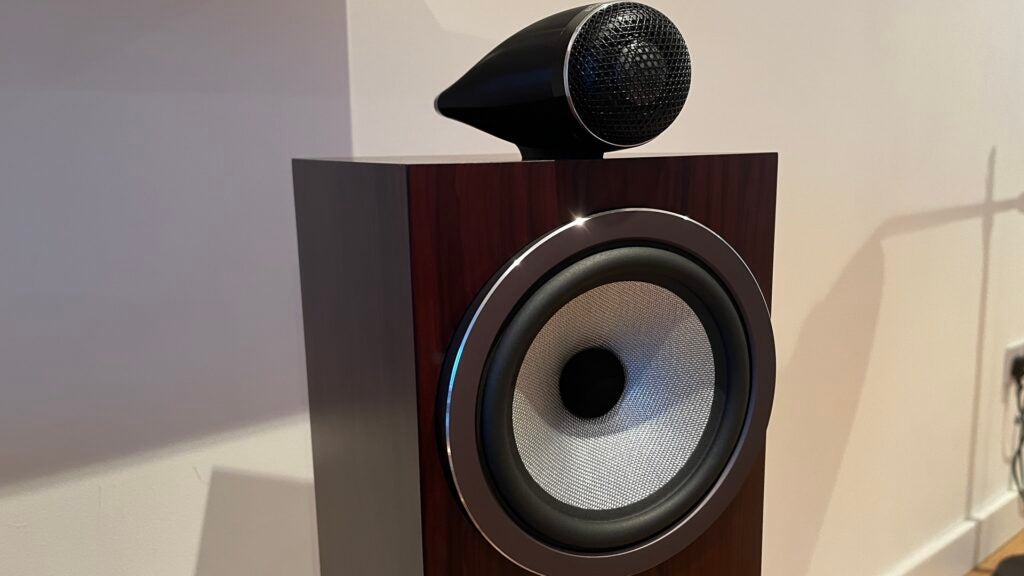Bowers and Wilkins 705 S3 Review
The toppermost of the tweetermost


Verdict
Tremendously capable and accomplished loudspeakers, yes, with the sort of straightforward musicality that can make even a strong listener weak at the knees. They’re no fans of lower volumes, though, and can be just a little fussy about the character of their partnering electronics.
Pros
- Clean, expansive and detail-heavy sound
- Individual looks, impeccable build quality
- Are generally unfussy about partnering equipment…
Cons
- …as long as it isn’t on the cool and/or analytical side
- Not especially tolerant of small volume levels
- Dedicated stands are very expensive
Introduction
The principle of trickle-down technology is well established. Lately, though, we’ve also become used to prices not so much trickling as surging upwards.
And so it is with the new Bowers & Wilkins 705 S3 – they incorporate plenty of the acoustic technologies originally developed for the company’s flagship 800-series loudspeakers, and they also cost a considerable chunk more than the 705 S2 loudspeakers they replace.
So the obvious question is: are the 705 S3 actually more up than down?
Availability
- UKRRP: £2600
- USARRP: $3399
- EuropeRRP: €3000
- CanadaRRP: CA$4499
- AustraliaRRP: AU$4799
The Bowers & Wilkins 705 S3 in the United Kingdom they cost a not-inconsiderable £2599 per pair. That translates to $3399 in the United States and AU$4499 in Australia. No matter the territory you’re shopping in, then, the 705 S3 represent a significant investment.
The 705 S2 they replace sold for £1799. Admittedly the S2 launched in 2018, when the world was an entirely different place – but nevertheless, the S3 has unarguably moved into an more rarefied area of the market. Bowers & Wilkins has lined the 705 S3 up against a different order of competitor – so does it compete?
Design
- Choice of three finishes
- Tweeter-on-top arrangement
- Curved front baffle for cabinet rigidity
Some companies have clambered aboard the current (and surely short-lived) vintage/retro hi-fi bandwagon by simply turning out new speakers that look like the speakers they were knocking out four or five decades ago.
Bowers & Wilkins, I’m happy to say, has no truck with this backward nonsense. Instead, the company has managed to make the 705 S3 look reasonably fresh and modern, and a definite evolution over the 705 S2, while ensuring they look entirely and only like a Bowers & Wilkins product.

So the 705 S3 cabinet is a little narrower than that of the S2, and its front baffle is curved in the manner of the B&W 800 series of speakers. The tweeter on top arrangement that sees the high-frequency driver separated from the main body, and that Bowers & Wilkins has been refining for donkey’s years, is present – but the aluminium solid-body housing is longer than before.
With the tweeter sitting on top of the main cabinet, the 165mm (which now sits in an external ‘pod’, another piece of 800-series thinking that’s made its way to the 700 range) can sit higher up than would otherwise be possible. From here, it can generate more energy.
When seen in profile, it’s apparent the tweeter module sits slightly forward of the main body of the cabinet. This is in an effort to achieve ideal time-alignment, the sonic Holy Grail of many a loudspeaker manufacturer.

At the back of the cabinet, the bi-wire speaker binding posts now sit in a neat horizontal line on their shiny plate. They’re towards the bottom of the cabinet, in order to give a wide berth to the larger-than-before bass reflex port.
Build quality, as is the norm with Bowers & Wilkins, is beyond criticism. The available finishes (gloss black and satin white are available in addition to the mocha wood of this review sample) look and feel good – and, almost as important, look and feel expensive.
So yes, this is how it’s done. At a glance, you might think little has changed over the outgoing 705 S2 – but in actual fact, almost everything has changed to a lesser or greater extent. Yet these could only be B&W loudspeakers. And that’s how you create a lineage without just delivering a facsimile of stuff you turned out yonks ago.
Features
- 25mm carbon dome tweeter
- 165mm Continuum mid/bass driver
- Optional (and pricey) stands
The tweeter-on-top enclosure is milled from a single, solid piece of aluminium and features a 25mm carbon dome tweeter at the business end. The enclosure is longer than the one fitted to the 705 S2, which allows for a longer internal tune-loading system – it’s designed to reduce soundwaves emanating from the rear of the tweeter and deliver a cleaner performance.
It’s isolated more efficiently from the main cabinet than previously, too, even though it feels less decoupled and consequently less likely to come away in your hand. It’s also where the only branding appears, which simultaneously makes Bowers & Wilkins seem casually understated and yet as confident as all get-out.

The 165mm Continuum mid/bass driver is carried over largely unchanged from the 705 S2 – which, given that it’s a high-performance item the material of which took B&W the thick end of a decade to develop, is predictable, sensible and undoubtedly a good thing.
Apart from some optional dedicated stands – the FS-700 S3 – which at £799 per pair are a significant investment in their own right, and probably not to be entered into by anyone who already owns half-decent stands, that’s about it as far as features go. This is a pair of passive loudspeakers, after all – and they tend not to need all that many features to get their particular job done.
Sound Quality
- Detailed and wide-open sound
- Organisation and drive to spare…
- …as long as volume levels are sufficient
It should really go without saying that anyone considering doing the thick end of three grand on a pair of loudspeakers really ought to have the electronics to bring the best from them. As we shall see in just a moment or two, the 705 S3 are more system-agnostic than many price-comparable rivals – but the fact remains that if you want to hear where your £2599 has gone, the rest of your system really needs to be up to snuff.

Ideally, the rest of your system will sound fairly animated too. I’m not about to suggest the Bowers & Wilkins are a dull or unengaging listen, you understand, but there’s no denying they’re slightly on the undemonstrative side of neutral. With some similarly placid music playing (Seymour Stein by Belle and Sebastian, for instance), the 705 S3 can sound just slightly pragmatic – and it’s a trait that’s a little more pronounced if you’re listening at modest volume levels.
Give them a little more heat and/or volume, though, and the 705 S3 undergo something of a transformation. With Minutemen’s Political Song for Michael Jackson to Sing playing at an assertive volume level, the Bowers & Wilkins come to life. They create a large and completely convincing soundstage, and give a proper sense of performance to the recording – without seeming to tangibly stick their oar in, they generate the sort of power and momentum on which the song thrives.

Low frequencies are shaped impeccably, detailed lavishly and underpin the presentation without sounding in any way showy. The opposite end of the frequency range is pure in the manner of a bell, with beautifully judged levels of bite and crunch to keep things realistic. And in between, the midrange communicates in the copious fashion – the amount of information the 705 S3 are able to impart regarding the character, technique and basic competence of a vocalist is almost indecent in its transparency.
The low-end discipline helps deliver pretty convincing rhythmic expression, and the speakers dispatch even symphony-orchestra levels of dynamic upheaval with something approaching disdain. The tiny harmonic variations that are revealed when the orchestra backs off and leaves a soloist to do their thing are spotlit and contextualised with only slightly less alacrity. In the best and most effective way, the Bowers & Wilkins 705 S3 take themselves out of the equation and simply hand over your music in the most unequivocal fashion.

No, they’re not the biggest fans of drier and/or more analytical electronics – perhaps because these are traits that they’re no strangers to themselves. As long as you avoid partnering equipment that overtly embodies these traits, though, the 705 S3 are happy to get along with more-or-less any system onto which they’re attached – even if there’s a bit of a price-ratio mismatch.
And no, they aren’t the most animated listen if you keep volume levels down at background level – but then you didn’t buy speakers as eloquent, as revealing and as absorbing as these in order to play them at background levels. Did you?
Latest deals
Should you buy it?
You value visual intrigue almost as much as you value sonic fidelity. The 705 S3 look like a pair of expensive Bowers & Wilkins loudspeakers, and they sound like it too.
Your existing system sounds less than animated. The 705 S3 need some reasonably gregarious amplification if you’re going to hear what they’re capable of.
Final Thoughts
How do you feel about the idea of pandering to your audio equipment? There’s no denying the 705 S3 are capable of a presentation of rare energy and excitement – but it’s not a default and neither is it guaranteed. You’ll need to indulge them in terms of the character of the equipment you partner them with, and you’ll need to show them the whip, volume-wise, too if you want to hear exactly what they’re capable of.
If you’re fine with this, dive right in – but if you feel all the pandering should happen in the opposite direction, you’ll need to think long and hard about these loudspeakers.
How we test
We test every hi-fi speaker we review thoroughly over an extended period of time. We use industry-standard tests to compare features properly. We’ll always tell you what we find. We never, ever, accept money to review a product.
Find out more about how we test in our ethics policy.
Tested for more than a week
Tested with real world use
FAQs
There is a dedicated stand for the 705 S3 in the FS-700 S3 but it is not included as standard. It is available separately for £800.








